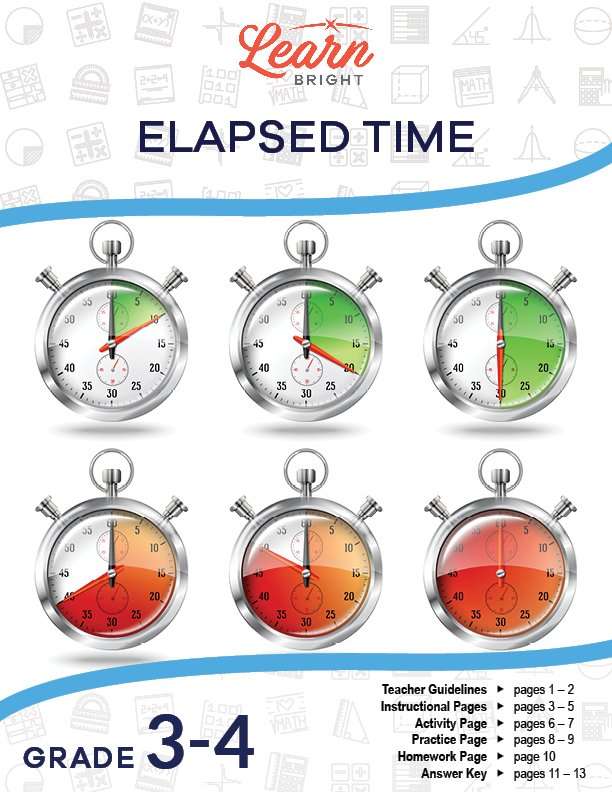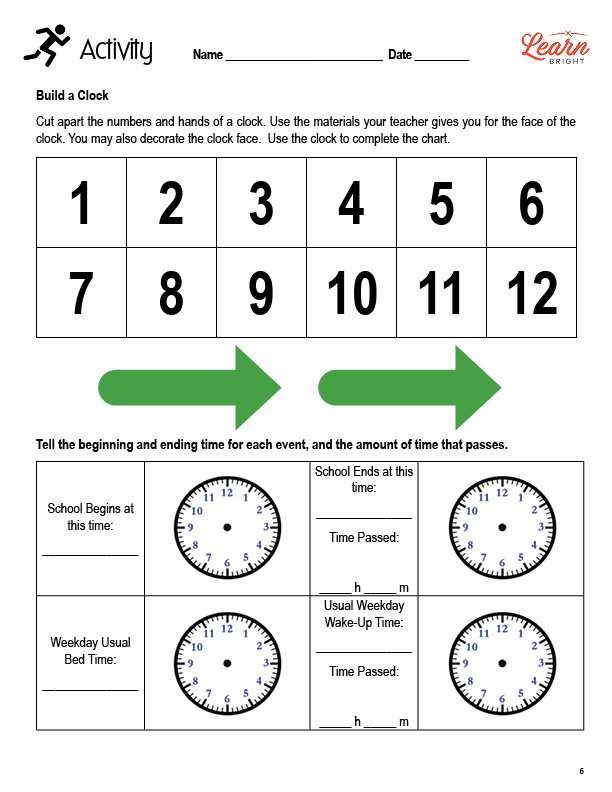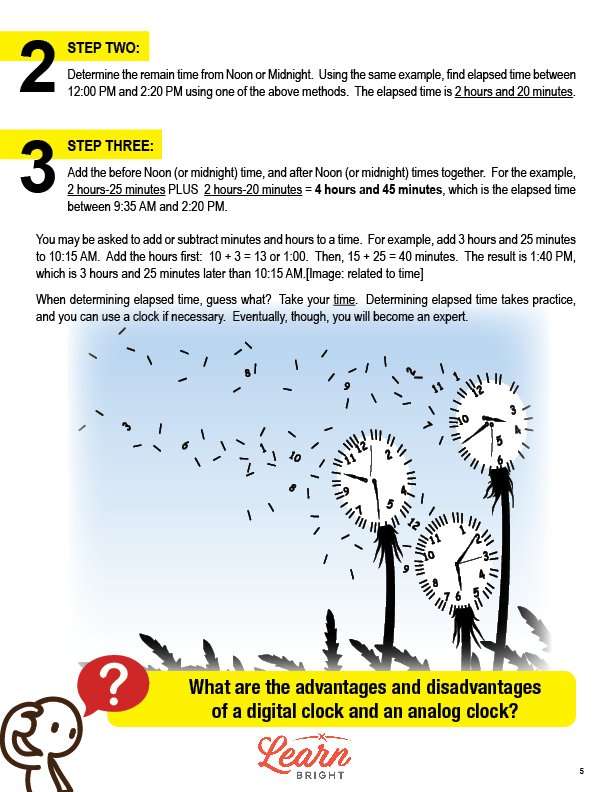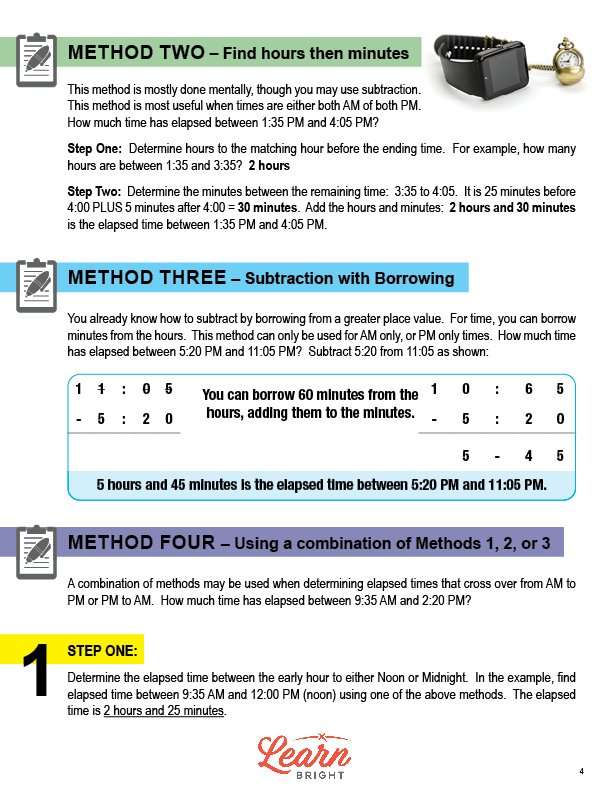Description
What our Elapsed Time lesson plan includes
Lesson Objectives and Overview: Elapsed Time provides practical activities for students to understand adding and subtracting minutes and hours to determine elapsed time. At the end of the lesson, students will be able to add and subtract minutes and hours to determine elapsed time. This lesson is for students in 3rd grade and 4th grade.
Classroom Procedure
Every lesson plan provides you with a classroom procedure page that outlines a step-by-step guide to follow. You do not have to follow the guide exactly. The guide helps you organize the lesson and details when to hand out worksheets. It also lists information in the blue box that you might find useful. You will find the lesson objectives, state standards, and number of class sessions the lesson should take to complete in this area. In addition, it describes the supplies you will need as well as what and how you need to prepare beforehand.
Options for Lesson
Included with this lesson is an “Options for Lesson” section that lists a number of suggestions for activities to add to the lesson or substitutions for the ones already in the lesson. Two optional adjustments to the lesson activity are to use cardboard for the activity clock hands and to give students beginning and ending times to use for the activity. For the Practice and Homework worksheets, you can allow students use of the model clocks. For an additional activity, you could have your students make “timelines” to determine passing time. Finally, send a note home for parents to request broken clocks for the class to take apart and see how a clock works.
Teacher Notes
The teacher notes page includes a paragraph with additional guidelines and things to think about as you begin to plan your lesson. This page also includes lines that you can use to add your own notes as you’re preparing for this lesson.
ELAPSED TIME LESSON PLAN CONTENT PAGES
Elapsed Time
The Elapsed Time lesson plan includes three content pages. You might have questions about what time actually is and how it works. One thing you probably do know about time is that it always moves forward and does not stop. The only control you have over time is how you spend, or use, it. You can keep track of time and determine how much time has elapsed, or passed.
It can be very easy to figure out how much time has elapsed. For example, if you have a class that begins at 1:00 and ends at 1:45, it’s easy to figure out that 45 minutes have elapsed. If you watch a show that start at 8:00 and ends at 10:00, 2 hours have elapsed. However, it’s not always that easy. For example, it’s harder to figure out how much time has elapsed between 7:20 AM and 4:45 PM.
We have a few different methods that you can use to determine elapsed time. You should try each method to figure out which one you like the best. Some methods may seem easier or harder to you, but all of them will tell you how much time has elapsed. The lesson walks through each method one by one.
Method One – Use a Time Number Line
For the first method, create a number line to illustrate the time between each hour, and add the starting time to the number line. Then, write in each hour from the starting time on. For example, we might want to find the elapsed time between 6:45 AM and 10:15 AM. For this problem, our number line has 6:45 AM, 7:45 AM, 8:45 AM, 9:45 AM, 10:45 AM, and so on. We’ll use this to help us with the next steps.
We begin at the starting time (6:45 AM) and count the hours to the nearest time without going past the ending time. 6:45 to 9:45 is 3 hours. Next, we determine the difference between 9:45 and 10:15, which is 30 minutes. We add the two together for a total elapsed time of 3 hours and 30 minutes.
Number lines can also be used for the hours between AM and PM, because you can change your number line based on the times given. You can also change the interval on your number line to 5, 10, 15, 20, 30, or any other number of minutes.
Method Two – Find Hours then Minutes
When using the second method, we usually solve the problem mentally. You can also use subtraction. This method is useful when both the starting and ending times are either AM or PM. For example, we might want to find the elapsed time between 1:35 PM and 4:05 PM.
To find the elapsed time with this method, we first determine the number of hours between the times without going past the ending time. In this case, there are 2 hours between 1:35 and 3:35. Next, we determine the minutes between the remaining time, 3:35 to 4:05. 3:35 is 25 minutes before 4:00 plus 4:05 is 5 minutes after 4:00. Therefore, the total minutes are 30 minutes.
Finally, we add the hours and minutes together for a total elapsed time of 2 hours and 30 minutes.
Method Three – Subtraction with Borrowing
When using the third method, we can subtract by borrowing minutes from the hours. We can only use this method when both times are AM or both times are PM. If we wanted to find how much time has elapsed between 5:20 PM and 11:05 PM, we would subtract. To do so, we need to to borrow 60 minutes from hours and add them to the minutes. Using this method, we can determine that the total elapsed time is 5 hours and 45 minutes.
Method Four – Using a Combination of Methods 1, 2, or 3
Sometimes it’s best to use a combination of the different methods, especially when the times cross over from AM to PM or PM to AM. For example, we might want to figure out how much elapsed time there is between 9:35 AM and 2:20 PM.
Step one is to find the elapsed time between the first hour to either noon or midnight. For this example, we’ll find the elapsed time between 9:35 AM and 12:00 PM (noon) using any of the above methods. The elapsed time here is 2 hours and 25 minutes.
Step two is to determine the remaining time from noon or midnight to the end time. For this example, we’ll find the time between 12:00 PM (noon) and 2:20 PM using any method. The elapsed time in this step is 2 hours and 20 minutes.
Step three is to add both times together to find the final answer. The elapsed time between 9:35 AM and 2:20 PM is 4 hours and 45 minutes, because 2 hours and 25 minutes plus 2 hours and 20 minutes equals 4 hours and 45 minutes.
Someone might ask you to add or subtract minutes and hours to or from a specific time. For example, you might need to add 3 hours and 25 minutes to 10:15 AM. To do this, you first add the hours (10 + 3 = 13, or 1:00). Next, add the minutes (15 + 25 = 40). The final time is 1:40 PM, which is 3 hours and 25 minutes after 10:15 AM.
When you’re finding elapsed time, make sure to take it slow and check your work! You can also try using a clock to help you as you practice.
ELAPSED TIME LESSON PLAN WORKSHEETS
The Elapsed Time lesson plan includes three worksheets: an activity worksheet, a practice worksheet, and a homework assignment. You can refer to the guide on the classroom procedure page to determine when to hand out each worksheet.
BUILD A CLOCK ACTIVITY WORKSHEET
The activity worksheet asks students to build their own clocks using the numbers and clock hands on the worksheet. They will then use their clock to complete the chart, requiring them to find the elapsed time between different activities.
ADD OR SUBTRACT PRACTICE WORKSHEET
For the practice worksheet, students will add or subtract the elapsed time for each problem.
ELAPSED TIME HOMEWORK ASSIGNMENT
The homework assignment asks students to complete the chart on the worksheet by filling in the elapsed time for each activity. They will then answer some questions about how much total time was spent on different activities, like driving and eating. Next, they will figure out how old they are in years, months, days, hours, and minutes by finding the elapsed time between their birth and today.
Worksheet Answer Keys
This lesson plan includes answer keys for the practice worksheet and the homework assignment. If you choose to administer the lesson pages to your students via PDF, you will need to save a new file that omits these pages. Otherwise, you can simply print out the applicable pages and keep these as reference for yourself when grading assignments.









